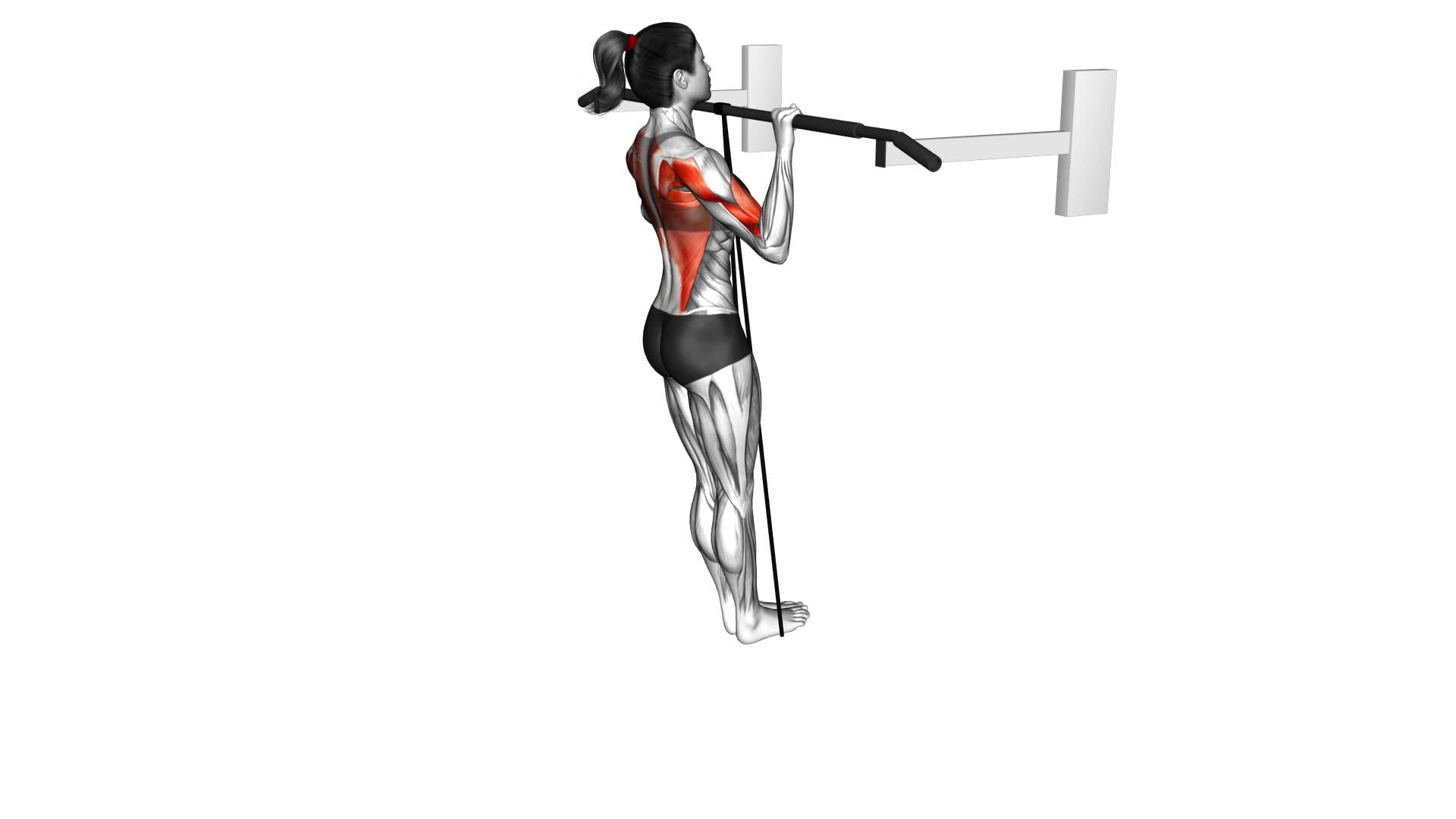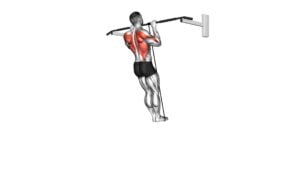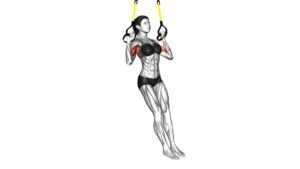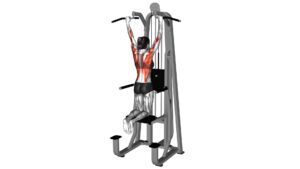Band Assisted Pull-Up (VERSION 3) (female) – Video Exercise Guide & Tips

Are you struggling with pull-ups? Don't worry, we've got you covered!
Watch This Exercise Video
In this video exercise guide, we'll show you how to master the Band Assisted Pull-Up (Version 3). This variation is specifically designed for females, helping you build strength and improve your upper body muscles.
With proper form and technique, you'll be on your way to conquering pull-ups in no time.
So grab a resistance band and let's get started!
Key Takeaways
- Band Assisted Pull-Up (VERSION 3) targets upper body muscles, including back, biceps, and shoulders.
- Engaging the core muscles for stability and balance is important during the exercise.
- Gradually increasing resistance as strength improves is crucial for progress.
- Proper form and technique, such as gripping the bar shoulder-width apart and keeping elbows close to the body, should be maintained for maximum effectiveness and to reduce the risk of injury.
Benefits of Band Assisted Pull-Up (VERSION 3) for Females
What are the benefits of Band Assisted Pull-Up (VERSION 3) for you as a female?
This exercise primarily targets your upper body, specifically your back muscles, biceps, and shoulders. It also engages your core muscles for stability and balance. By performing Band Assisted Pull-Up (VERSION 3), you can strengthen and tone these areas, giving you a more defined and sculpted upper body.
When it comes to choosing the right resistance band for this exercise, it's crucial to consider your fitness level and goals. The band should provide enough assistance to help you complete the exercise with proper form, but not too much that it becomes too easy. It's recommended to start with a lighter resistance band and gradually increase the resistance as you become stronger.
To properly choose the right resistance band, you need to consider your current strength and the number of repetitions you can comfortably perform. If you can easily complete more than 10 repetitions, the band may be too light, and you should switch to a higher resistance level. On the other hand, if you struggle to complete even a single repetition, the band may be too heavy, and you should opt for a lighter one.
Proper Form and Technique for Band Assisted Pull-Up (VERSION 3)
To perform Band Assisted Pull-Up (VERSION 3) with proper form and technique, position yourself beneath the pull-up bar. Follow these steps to ensure you're executing the exercise correctly:
- Select the appropriate band resistance: Choose a band that provides enough support to assist you in completing the pull-up while still challenging your muscles. The band should allow you to maintain proper form throughout the movement.
- Grip the bar shoulder-width apart: Grasp the pull-up bar with an overhand grip, placing your hands slightly wider than shoulder-width apart. This grip will engage your back and arm muscles effectively.
- Engage your core and initiate the movement: Begin by engaging your core and pulling your shoulders down and back. As you pull yourself up, focus on using your back muscles to drive the movement. Keep your elbows close to your body and try to touch your chest to the bar.
For beginners, modifications can be made to make the exercise more manageable:
- Place a foot on the band: If you're struggling with the full weight of your body, loop the band around one foot and use it for assistance. This modification reduces the resistance and makes the pull-up easier to perform.
- Use a thicker band: If the band you're using provides too much assistance, try using a thicker band or multiple bands to decrease the level of support. Gradually decrease the assistance as you build strength.
- Partial range of motion: If you're unable to perform a full pull-up, start by doing partial range of motion pull-ups. Lower yourself as much as you can and gradually increase the range of motion over time.
Progression Tips to Help You Master the Band Assisted Pull-Up (VERSION 3)
To progress and master the Band Assisted Pull-Up (VERSION 3), focus on gradually reducing the assistance provided by the band while maintaining proper form and technique. Progression techniques are essential to help you build strength and eventually perform unassisted pull-ups. Here are some tips to help you on your journey:
- Decrease band assistance gradually: Start with a band that provides enough assistance to help you complete the exercise with proper form. As you become stronger, switch to a band with less resistance or use a thinner band.
- Increase repetitions: Once you can perform a certain number of repetitions with proper form, challenge yourself by increasing the number of reps. This will help build endurance and prepare you for more advanced pull-up variations.
- Use different equipment options: Besides bands, you can also use other equipment like assistance machines or TRX straps to progress towards unassisted pull-ups. Experiment with different options to find what works best for you.
Remember, mastering the Band Assisted Pull-Up (VERSION 3) takes time and consistency. Keep practicing and challenging yourself, and soon you'll be able to perform pull-ups without any assistance.
Now let's move on to the next section, where we'll discuss common mistakes to avoid when performing the Band Assisted Pull-Up (VERSION 3).
Common Mistakes to Avoid When Performing Band Assisted Pull-Up (VERSION 3)
As you strive to master the Band Assisted Pull-Up (VERSION 3), it's crucial to be aware of common mistakes to avoid during the exercise. By recognizing and correcting these errors, you can maximize the effectiveness of your workout and reduce the risk of injury.
Here are three common mistakes to watch out for and tips for improvement:
- Using too much assistance: One mistake many people make is relying too heavily on the band for assistance. While it's tempting to make the exercise easier, it's important to challenge yourself. Gradually decrease the assistance provided by the band to build strength and improve your ability to perform unassisted pull-ups.
- Neglecting proper form: Another mistake is sacrificing form for quantity. Avoid swinging your body or using momentum to complete the movement. Instead, focus on maintaining control and engaging your back muscles throughout the exercise. This will ensure that you're targeting the right muscles and getting the most out of each repetition.
- Not progressing gradually: Lastly, rushing the progression can hinder your progress. Take your time to build strength and master each level before moving on to the next. This will help prevent injuries and ensure that you're building a solid foundation for more advanced pull-up variations.
By avoiding these common mistakes and following these tips for improvement, you'll be well on your way to mastering the Band Assisted Pull-Up (VERSION 3).
Now, let's explore the variations and modifications of this exercise specifically designed for females.
Variations and Modifications of Band Assisted Pull-Up (VERSION 3) for Females
Continue building your strength and mastering the Band Assisted Pull-Up (VERSION 3) by exploring variations and modifications specifically designed for females. These variations and modifications can help you progress and challenge yourself as you work towards achieving your pull-up goals.
One variation you can try is the assisted pull-up with a lighter resistance band. If you have been using a thicker band for assistance, switching to a lighter one can increase the difficulty of the exercise. This will require more strength from your upper body and help you build the necessary muscles for an unassisted pull-up.
Another modification you can make is to use a wider grip. By placing your hands wider apart on the bar, you engage different muscle groups, particularly your lats and upper back. This variation targets these areas more intensely and can help you develop the necessary strength for a full pull-up.
Furthermore, you can also incorporate negatives into your training. Negatives involve focusing on the lowering phase of the pull-up rather than the lifting phase. By slowly lowering yourself from the top position, you work the same muscles used in a pull-up but in a different way. This can help you build strength and control, ultimately leading to a full pull-up.
Frequently Asked Questions
How Long Does It Typically Take to Progress From Using a Band to Doing an Unassisted Pull-Up?
It typically takes time and consistency to progress from using a band to doing an unassisted pull-up. The progression timeline varies for each individual, but with regular practice and dedication, you can see improvement over a few weeks or months.
In addition to band-assisted pull-ups, you can incorporate alternative exercises like lat pulldowns, inverted rows, and negative pull-ups to strengthen the muscles needed for unassisted pull-ups.
Remember to listen to your body and gradually challenge yourself as you progress.
Can Band-Assisted Pull-Ups Help With Improving Grip Strength?
Band-assisted pull-ups can definitely help improve your grip strength. By using bands to assist you in the exercise, you can focus on developing the strength in your hands and fingers. This is important because grip strength plays a crucial role in many exercises and daily activities.
Additionally, band resistance training has numerous benefits, such as increasing muscle activation and providing progressive resistance. So, incorporating band-assisted pull-ups into your routine can be a great way to enhance your grip strength training exercises.
Are There Any Specific Warm-Up Exercises or Stretches Recommended Before Attempting Band-Assisted Pull-Ups?
Before attempting band-assisted pull-ups, it's important to warm up properly and stretch to prevent injury.
Specific warm-up exercises like jumping jacks or arm swings can get your blood flowing and increase your range of motion.
Recommended stretches for the upper body include shoulder circles and tricep stretches.
These exercises and stretches will prepare your muscles for the demands of the pull-up and help you perform at your best while minimizing the risk of strains or pulls.
Can Band-Assisted Pull-Ups Be Beneficial for Individuals With Shoulder or Upper Back Injuries?
Band-assisted pull-ups can be beneficial for individuals with shoulder or upper back injuries. These exercises provide support and assistance, allowing you to work on your upper body strength without putting too much strain on your injured areas.
By using the resistance bands, you can gradually increase your strength and stability, promoting rehabilitation and preventing further injury.
Incorporating band-assisted pull-ups into your workout routine can help you regain strength and improve your overall upper body function.
Are There Any Specific Recommendations for Incorporating Band-Assisted Pull-Ups Into a Full Upper Body Workout Routine?
When incorporating resistance bands into your full upper body workout routine, there are a few recommendations to keep in mind.
Start by warming up your muscles with dynamic stretches.
Then, perform a few sets of band-assisted pull-ups to target your back and arms.
If you have shoulder or upper back injuries, consider alternative exercises like lat pulldowns or seated rows.
Remember to maintain proper form and gradually increase the resistance of the bands as you get stronger.
Conclusion
In conclusion, the band assisted pull-up (version 3) is a beneficial exercise for females looking to improve their upper body strength and achieve their pull-up goals. By using proper form and technique, progressing gradually, and avoiding common mistakes, females can effectively master this exercise.
Additionally, there are variations and modifications available to cater to different fitness levels and abilities. Incorporating the band assisted pull-up (version 3) into your workout routine can lead to significant improvements in strength and overall fitness.

Author
Years ago, the spark of my life’s passion ignited in my mind the moment I stepped into the local gym for the first time. The inaugural bead of perspiration, the initial endeavor, the very first surge of endorphins, and a sense of pride that washed over me post-workout marked the beginning of my deep-seated interest in strength sports, fitness, and sports nutrition. This very curiosity blossomed rapidly into a profound fascination, propelling me to earn a Master’s degree in Physical Education from the Academy of Physical Education in Krakow, followed by a Sports Manager diploma from the Jagiellonian University. My journey of growth led me to gain more specialized qualifications, such as being a certified personal trainer with a focus on sports dietetics, a lifeguard, and an instructor for wellness and corrective gymnastics. Theoretical knowledge paired seamlessly with practical experience, reinforcing my belief that the transformation of individuals under my guidance was also a reflection of my personal growth. This belief holds true even today. Each day, I strive to push the boundaries and explore new realms. These realms gently elevate me to greater heights. The unique combination of passion for my field and the continuous quest for growth fuels my drive to break new ground.



